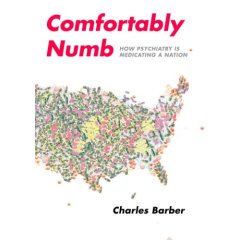
Another of his classic essays is the following, titled “Prozac Nation?” in which Kramer refutes the modern wave of thought that we are overmedicating our country, numbing America to every hiccup or discomfort, and doling out antidepressants where there is no legitimate diagnosis.
You can get to the original article, which ran in “Slate,” by clicking here. You can get to Kramer’s website by clicking here.
In the waning months of the Carter administration, and of my own brief stint in the Department of Health, Education, and Welfare, I was detailed to develop a document for the signature of the surgeon general, Julius Richmond. A feminist group had asked for an assessment of the “mother’s little helper” problem, the tendency of doctors (so went the widely held assumption) to prescribe Valium instead of listening to their patients. This inquiry occurred in the context of a broader discussion about whether America was becoming an overmedicated society–whether we were peculiarly averse to discomfort and enamored of the quick fix. And so I convened experts from the National Institute of Mental Health and other federal agencies to assess what was known about women and the use of prescribed psychotherapeutic medications.
The exercise taught me how difficult it is to find facts that bear on beliefs about drug use. By the 1970s, in any given year, almost one-quarter of all women had used a psychotherapeutic medication, and about 10 percent of men. But women reported more negative life events and responded to them with more symptoms. It was patients with high levels of distress who had received medication, and high distress correlated with diagnosable illness. That was the sort of information we had–indirect, coarse-grained. We did know that the French and the Swedes were prescribed more psychiatric medicines than were Americans, and that many Americans failed to renew their scrips even once. The newer medications, like Valium, were safer than older drugs, like barbiturates, which accounted for six times as many deaths per prescription written. Nor did addiction trends show a clear pattern.
My task force drafted a circumspect letter saying that little in the scientific literature suggested a crisis or even a uniquely American response to anxiety. Later, I helped analyze data that found that general practitioners provided more “therapeutic listening” to women than to men. Prescribing did not replace “quality time”; it supplemented it. Still, the important questions remained unanswerable. No one had done fly-on-the-wall studies to see how doctors assess patients. Even detailed information about diagnosis and prescribing would not resolve the technical and philosophical debates. Some psychiatrists believed that anti-anxiety medications had a justifiable role in the treatment of depression, so that apparent mistaken prescribing might represent “street smarts” on the part of GPs. Meanwhile, public-health advocates were skeptical of the diagnostic system and the related pharmacology research. It did seem that Valium was playing a signal role in the culture. Think of Jill Clayburgh; three of her films in this era–An Unmarried Woman, Starting Over, and I’m Dancing as Fast as I Can–featured Valium.
A quarter century later, the evidence about mother’s little helpers is no clearer, but the case can be made that what was at stake had less to do with medication than with society at large. Yes, Valium had its beneficiaries and its victims. But the broad trends now look to have had their own momentum–more conflicting responsibilities for women, less time with patients for doctors, and a loss of cohesion and gravitas throughout the culture. In retrospect, Valium supplied convenient metaphors for change to which it contributed minimally. Two or three decades down the road, will today’s widespread concern over antidepressant prescribing have a similar feel?
Charles Barber certainly does not think so. In Comfortably Numb: How Psychiatry Is Medicating a Nation, he makes the case that Prozac and its peers are threats to the health and civility of the nation. Once again, the drug reveals America as it is–commercial and unreflective. Barber writes: “The SSRIs are at the epicenter of emotional entitlement, its ultimate symbol and its ultimate expression.” These concerns about the drugs’ cultural impact are ones I raised in 1993, in the form of thought experiments, in Listening to Prozac. Effectively, Barber’s claim is that my worst fears have come to pass, that America has become a dystopia, through the use of antidepressants.
If nothing else, Barber, a caseworker with the chronically mentally ill who has gone on to teach at Yale, has assembled a handy compendium of evidence for the belief that we are overmedicated. He reports that 33 million Americans took a psychiatric drug in 2004. He finds abundant signs that the stigma of mental illness is decreasing, a change he deems ominous because of the accompanying growth in comfort with medication use. Barber mounts the customary attack on psychiatry’s promiscuous diagnosing, the FDA’s toothless oversight, Big Pharma’s baneful influence, and the society’s embrace of reductionistic theories of the mind. Barber does believe that medication, and not psychotherapy, is the best treatment for serious depression; but he says that most antidepressants are prescribed for ill-defined maladies for which drugs are ineffectual. To reverse our self-indulgence, Barber favors cognitive behavior therapy and an increased tolerance for melancholy, emotional pain, and even frank depression.
The problem with this line of argument is that it lacks perspective. Barber dips into history, and he amasses popular references (Oprah, The Sopranos), but his conclusions are ahistorical, his cultural reach is narrow, and his facts are often simply wrong.
Barber trumpets, “To say that we are the most psychiatrically medicated nation on earth is a prodigiously absurd understatement.” As regards antidepressants, he buttresses this claim by citing pharmaceutical sales; but paying high prices is not the same as taking more pills. According to a study from the MIT Sloan School of Management, on a per capita basis, by the year 2000 Swedes and Canadians had begun taking more antidepressants than we do.* Greece, Italy, Spain, and (again) Sweden used a larger proportion of new, on-patent antidepressants than did the United States. The authors concluded that on the variables studied, the United States “is often ‘in the middle’ relative to other countries, and is not an outlier.”
Depression goes with latitude. Perhaps the Swedes and Canadians should seek more treatment than we do. But the British and the Portuguese are generally clustered with us, as well. The transatlantic perspective suggests that Oprah, the FDA, and the American Psychiatric Association–never mind the American character–cannot bear the entire burden for our prescribing patterns.
As for a surge in usage, 33 million Americans is 11 percent of the population. Sampling techniques have changed; data from the 1970s excluded children and the elderly, and the populations studied tended to be urban. Even so, any difference between prescribing now and then is not so great as Barber would have us imagine. As in the past, substantial percentages of patients–Barber says one-third–do not refill their scrips. And once again, the newer medications are safer in overdose than older drugs in the same category. The more distance you take, the harder it is to make the case that our current circumstances are unique.
The notion that we embrace too many subclinical conditions as treatable is likewise myopic. In the 1950s and ’60s, almost everyone who was not psychotic qualified for a diagnosis of neurosis. Who was not a candidate for psychoanalysis? That treatment carried little stigma. In some circles, cachet was attached to it, as an indulgence for the elite. Medication arouses more controversy, in part because of the broad population that can access it. But it is hard to argue that more people are diagnosable today than in the heyday of Freudianism. And as regards treatment and stigma, if our tolerance has spread to medication, is that change entirely for the worse?
Psychotherapies are effective, and they are underutilized–on these points, doubtless Barber is right. But even here, his pronouncements sound a bit off. Barber writes, “In the high-tech age of Corporate Psychiatry, efforts like CBT don’t get the press they should.” But in 2007, Newsweek and O gave CBT coverage, and a cognitive therapy book was a best seller–hardly signs that the treatment is off our radar. Nor is psychotherapy research free from the problem of bias that dogs medication testing. In The Great Psychotherapy Debate, Bruce Wampold found that CBT’s special contribution has been exaggerated. (One problem: Widely used rating instruments, developed by cognitive therapists, favor CBT by emphasizing change in cognition as a key outcome.) Neutral research finds that most therapies work equally well. A humane view might be less sectarian than Barber’s. The bulk of studies find that it’s relationship–the therapeutic alliance–that matters, not techniques particular to any one approach.
Too much Prozac? To my mind, the most interesting data appeared in a study by Benjamin Druss and others, published last October. It found that nearly 40 percent of people who received mental-health services, including medications prescribed by a family doctor, did not meet diagnostic criteria for illness. But more than half of those undiagnosed patients had suffered mental illness in the past. Of the remaining 18 percent, more than half had one of three other indicators of need: a prior mental hospitalization, a syndrome one symptom shy of a diagnosis, or a serious recent stressor like divorce or rape. The final 8 percent, those who received services with no explanation, were largely treated outside the medical system, by clergy or self-help groups.
Again, our best analyses are inexact. But they point to the limits of the problem under discussion. Wild prescribing hardly seems to be at issue. Still, we must ask: Should rape victims (and others under stress) who have no clear mood disorder receive mental-health services, and which ones? How effective are antidepressants for patients with four rather than–as the diagnostic manual demands–five depressive symptoms? Are general practitioners sloppy or perspicacious? These questions are serious. They are difficult. They are not uniquely American. They are not new.
The issue that Barber addresses, distinguishing the treatment of disease from what I have called “cosmetic psychopharmacology,” remains important. And it’s not that Barber is wrong about the culture. Big Pharma wields too much influence. Soft technologies like psychotherapy get short shrift. The world is too much with us; late and soon, getting and spending, we lay waste our powers. But there is a danger in taking a narrow viewpoint–making our time and place out as exceptional and so finding constant crises.
Likewise, there is risk in answering questions prematurely. Finally, how antidepressants interact with capitalism remains uncertain. We may–this concern was at the core of Listening to Prozac–be using medication to achieve the assertiveness and confidence that our society demands. Or, as Barber suggests, we may be numbing ourselves. But two other possibilities remain on the table. We may be doing pretty well with the imperfect medicines we have. Or we may still be failing to reach numbers of people with substantial mental illness.

